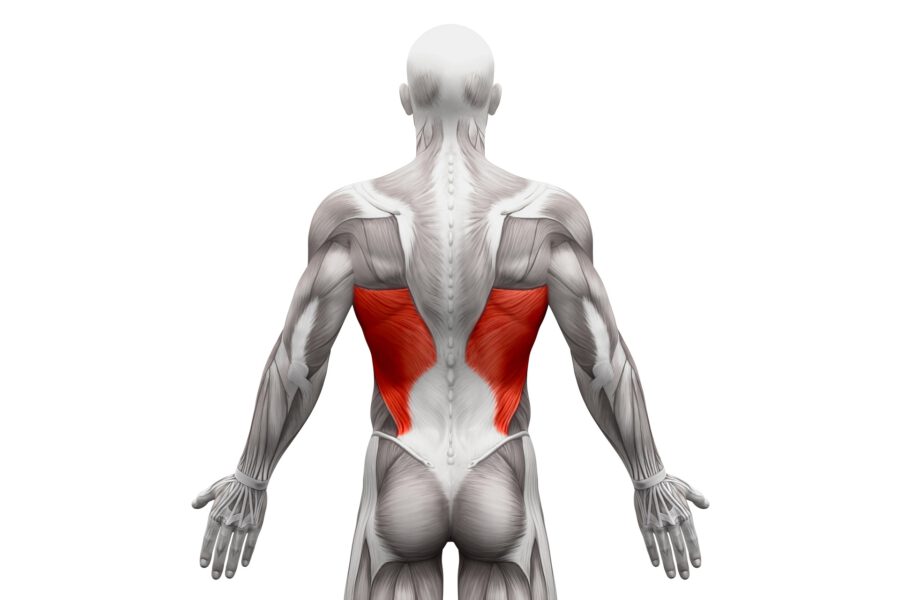Optimized Lat Training: Everything You Need to Know
Few things make the upper body look as huge as a pair of wide, thick lats. Getting them takes smart training with exercises that move the fibers through their full range of motion. Most traditional lat exercises don’t do a very good job of that basic task. In this article, I’ll reveal the best exercises to optimally work the lats and get you on route to the thick, v-shaped upper back that your hard work deserves.
The latissimus dorsi is the broadest muscle of the back. It attaches at the upper arm, and along the spine to the thoracolumbar fascia of the lower back. The muscle fibers of the lats are mostly diagonal. The origins of the muscle fibers are mostly on the spine and on the upper-inner part of the posterior pelvis.
The function of the lats is to pull the upper arm down and in toward the center of the torso.
The best lat exercises will do the following three things:
- Follow the direction of the muscle fibers
- Pull toward the origin of the muscle fibers
- Originate from a position that is directly opposite the pulling motion
So, what do we get from this?
Firstly, the ideal angle of movement to work the lats is a diagonal movement. That’s because, as we’ve seen, the muscle fibers run diagonally from the spine to the upper arm. In pulling to the origin of the muscle fibers, there will also be diagonal movement from a fully extended arm position down and in toward the hip.
The most commonly performed exercises for the lats (pulldowns and pull ups) involve vertical rather than diagonal movement. These are not fully activating the lats. Neither are horizontal rowing movements like seated rowing or bent over barbell rows.
Clearly the best lat exercises will have you starting from a position where your arm is extended out at an angle of about 45 degrees and then pulling the arms down and in so that the elbow makes contact with the hip bone. That range of motion will move your latissimus dorsi through its full range of motion.
It is also far better to work the lats unilaterally (one arm at a time) than working both sides together. That’s because it is impossible to pull down a bar and bring both arms in together at the same time.
- Place a back supported bench in front of the pulley machine with the pulley set about a foot above head height when seated. Sit on the seat and grab the pulley with your right hand. Adjust your positioning so that your upper arm is at 45-degree angle.
- Pull the handle in and down toward your hip. Turn your head and shoulder toward the working lat as you pull down.
- Hold the contracted position for 1-2 seconds and then return to the start position under control.
Use a double pulley machine and set both sides with the seat sitting between them. Do a set with one side then repeat with the other side. Go back and forth with no rest between sides to complete your sets.
- Sit on a lat pulldown machine, facing the machine and grabbing the bar with a wide grip.
- Pull the bar down, rocking the right elbow down and in toward your hips as low as you can.
- Return to the top position.
- On the next rep, rock down with the left elbow.
This modification of the lat pulldown transforms the movement from a vertical to a mostly diagonal movement. It is nowhere near as good as the lat pull in, but will activate the lats far more than the traditional lat pulldown - You may have to reduce the weight to be able to move through the full range of motion on this exercise.
Here’s a back workout you should try:
- Hang from a pull up bar at a dead hang. Retract your scapula and lift your chest. Your body should be tight with legs straight and a slight forward hinge at the hips.
- Pull up through the elbows and rock to the left hand side so that the elbow comes down toward the hip in the top position. This movement will be slight because your hands are fixed but you should focus on achieving a contraction in the lower lat as you bring the elbow and hip as close together as possible.
- Lower and repeat.
By performing a rocking motion with your elbow, you will be able to correct the range of motion of the pull down to move through more of a diagonal than a vertical range of motion. Perform the movement slowly and deliberately.
The lat pull in is the single best exercise you can do for the lats. If you’re interested in doing just the best, then it should form the start and finish of your lat training workout. After all, why switch from an exercise that's a ‘10’ to one that’s a ‘7’ just for the sake of variety?
Do a total of 12 sets with a rep range between 30 on the first set and six on the last two sets, using a pyramid scheme where you increase the weight as the reps come down.
If you want to add some variety to your training, add in rocking pulldowns and rocking pull ups, so that you are doing 4 sets of each exercise.
You now know what the best lat exercises are to optimally activate the muscle for maximum growth and strength potential. Obviously, this is different to the popular notion of what a lat workout should look like. Give it a try for 6 weeks and decide for yourself whether it's worth following.

